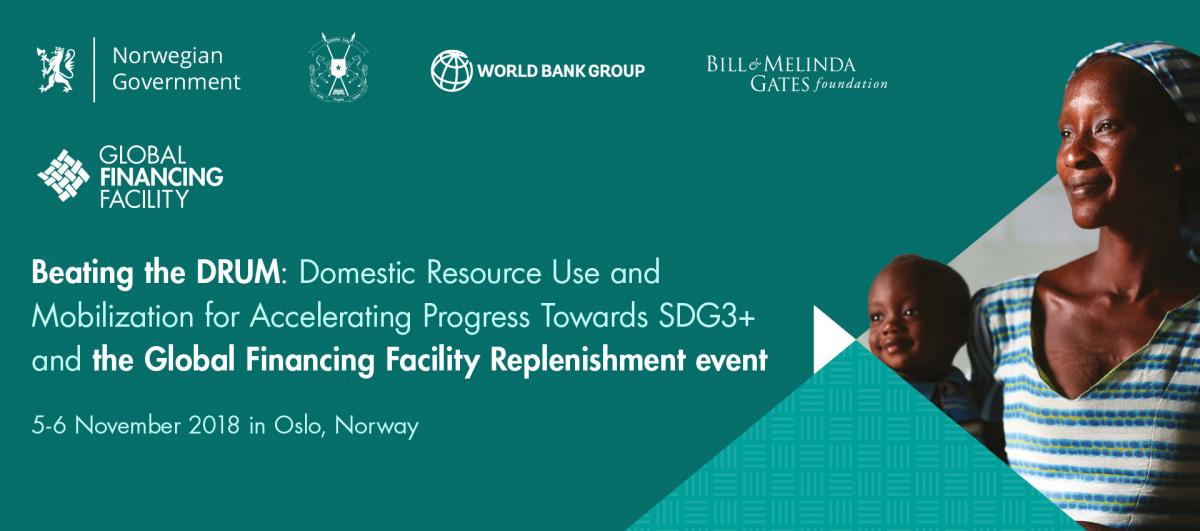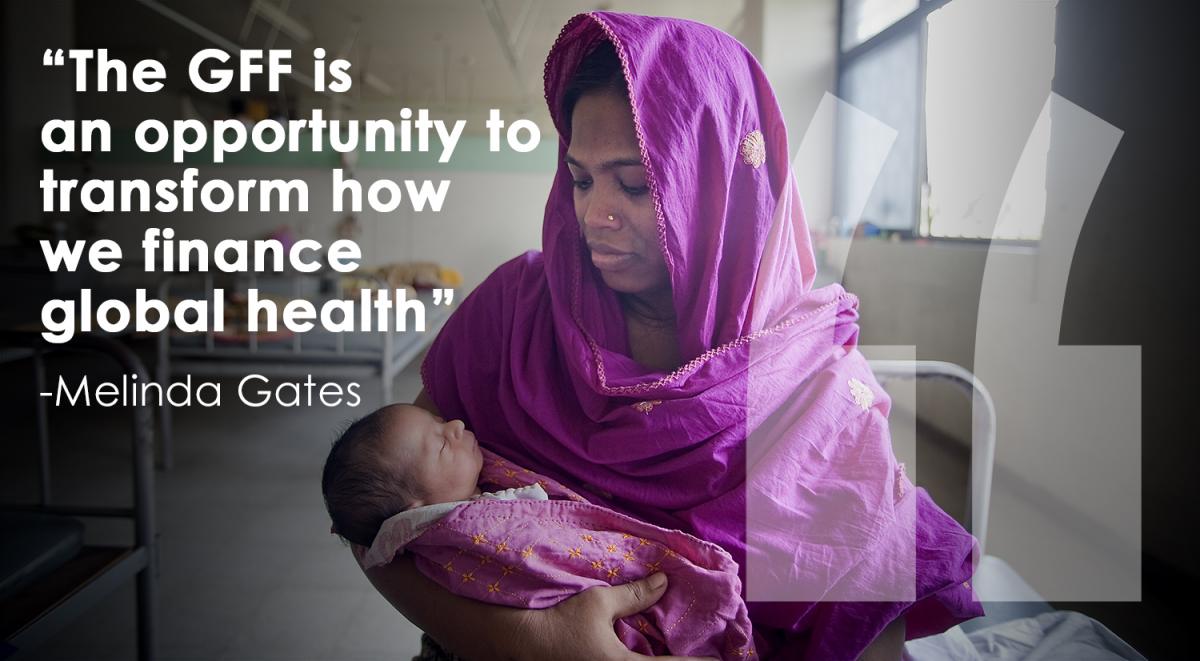GFF Replenishment
Over 5 million women and children are still dying from preventable conditions in 50 countries every year, despite significant progress. A new approach is needed.
With the GFF’s innovative financing model, countries have the unique opportunity to transform how they prioritize and finance the health and nutrition of their people, especially women, children and adolescents. And they can do so in a way that is self-sustaining, that helps their economies grow, and that enables them to keep investing in their people.
After our creation in 2015, we are already halfway to supporting the 50 countries with the greatest need.
Co-hosted by the Governments of Norway and Burkina Faso, the World Bank Group, and the Bill & Melinda Gates Foundation, our replenishment conference in November aims to raise additional funding so we can expand support to all 50 countries.
Event Details
Working in partnership, we can save up to 35 million lives by 2030, and greatly improve the lives of millions of women, children and adolescents, and empower countries to build sustainable futures.
Sixteen countries are already benefiting from the approach and we are working with a further eleven countries on the prioritization and financing of the health of women, children and adolescents. These partnerships are made possible by generous initial contributions to the GFF Trust Fund from governments of Canada, Denmark, Japan, Norway, UK, the Bill & Melinda Gates Foundation, and MSD for Mothers.
Ten reasons to invest in the GFF
REASON #1: THE GFF INVESTS IN HUMAN CAPITAL
Investing in people is a critical step for boosting economic growth and ending extreme poverty. Established in 2015, the GFF is designed as an innovative financing mechanism to close the significant financing gap needed to eliminate preventable maternal and child deaths worldwide. The GFF process helps governments and their partners to prioritize, focus on results, and tackle the main system bottlenecks to achieve impact at scale, which in turn is critical to achieving universal health coverage.
REASON #2: THE GFF LEADS ON CATALYTIC HEALTH FINANCING
A new model for scaled and sustainable financing is at the heart of what makes the GFF Trust Fund a pathfinder for the SDG era of financing for development, catalyzing the following sources of funding:
- Domestic resource mobilization (DRM). Because of the GFF process, Cameroon is increasing its budget for women and children’s health from 6 to 22 percent by 2020. Guatemala’s grant from the GFF Trust Fund is used to buy down the interest on an International Bank for Reconstruction and Development (IBRD) loan for a national stunting-reduction program, matched by domestic resources. These resources will finance a conditional cash-transfer program that targets families with children between ages 0 and 15, promoting health visits for children ages 0 to 6 and pregnant women and school attendance for children ages 6 to 15.
- Concessional Financing (IDA/IBRD). The GFF directly links GFF Trust Fund grants to substantially higher amounts of International Development Association (IDA) funding than initially expected. The current ratio of GFF Trust Fund grants to IDA is 1 to 6.9. With a historically large IDA window for IDA18 (US$75 billion, 2018–20), a vast window of opportunity has opened to frontload GFF Trust Fund investments and thereby accelerate progress on the SDGs, closing the financing gap.
- Alignment of external assistance. In the past three years, the GFF country-led multi-stakeholder platforms have contributed to donor alignment and harmonization, increasing the efficiency of individual and collective investments made by partners. GFF support for resource mapping has helped align donor and government funding to the costed priorities of the investment case for reproductive, maternal, newborn, child and adolescent health and nutrition (RMNCAH-N). To date, at least three bilateral partners are aligning their financing to the priorities of the investment case in 10 countries belonging to the first round of 16 GFF countries.
- Private sector. The GFF is developing and implementing innovative financing instruments to crowd in private capital to help close the financing gap. These instruments leverage a combination of flexible grant funding from the GFF Trust Fund and the financing expertise available within the World Bank Group and among GFF and its partners. The GFF also facilitates partnerships with the global private sector, enabling GFF countries to deploy private sector capabilities to deliver on IC objectives (including support for service delivery and the development of supply chains to reach the frontline of health systems).
REASON #3: THE GFF IS POWERED BY COUNTRY-DRIVEN PARTNERSHIPS
Partnership is the GFF model, with the GFF ensuring that there is financing behind common global health priorities and mandates. Instead of building new, parallel structures, the GFF invests in existing institutions and helps countries to bring together key multilateral stakeholders—including the United Nations, WHO, Gavi, the Vaccine Alliance, and the Global Fund to Fight AIDS, Tuberculosis and Malaria (Global Fund)—as well as bilateral, private-sector, and civil society organizations at the national level and the GFF Investors Group at the global level. By bringing all key stakeholders together to support the development and implementation of a single country-led investment case, the GFF enables both countries and stakeholders to identify their comparative advantages, avoiding duplication and reducing gaps. The GFF Trust Fund supports countries in mapping resources and aligning funders around the investment case and in identifying the key health financing reforms they need to make to mobilize their domestic resources, and it collaborates in expenditure tracking as well. GFF-supported countries have their own South-to-South learning network, sharing successes and failures in real time and learning from each other. In countries like the Democratic Republic of Congo, Cameroon, and Guatemala, the GFF is working with Gavi and the Global Fund to deliver results for countries.
REASON #4: THE GFF STRENGTHENS HEALTH SYSTEMS AND ENGAGES IN HEALTH FINANCING REFORMS
The GFF focuses on the critical stages of the life cycle: pregnancy, birth, the early years, and adolescence. In the ongoing effort to identify high-impact RMNCAH-N interventions and critical system bottlenecks to achieving impact at scale, the comparative advantage of the GFF approach is that its investment case goes beyond specific interventions and disease-specific approaches, helping countries to build more resilient primary health care services and systems.
REASON #5: THE GFF EMPLOYS A MULTISECTORAL APPROACH
The GFF shifts the focus from inputs to health and nutrition outcomes, taking into account multisector drivers, including health, education, water sanitation and hygiene (WASH), gender, nutrition, and social protection. For example:
- Education and gender: Bangladesh is tackling adolescent pregnancy by working to reduce the high rate of young girls dropping out of secondary education. The GFF Trust Fund is investing in gender-responsive schools there (criss-crossing the sectors of hygiene, sanitation, and health education) as well as in the health sector.
- Nutrition accounts for about 19 percent of total GFF and IDA/ IBRD cofinanced operations that have been approved to date by the World Bank Group, and this proportion is expected to grow as development in the early years is increasingly emphasized.
- Sexual and reproductive health and rights, including family planning, account for more than 30 percent of the current GFF portfolio, enabling countries to increase their investments in adolescent reproductive health as well as in broader gender, education, social protection, and other rights issues.
REASON #6: THE GFF HAS A STRONG EQUITY FOCUS
Countries prioritize funding for those populations most left behind, often people living in geographically remote or fragile areas that risk spiraling into instability. Because of this focus, the GFF steers financing and implementation support to fragile areas—focusing on the front lines first.
REASON #7: THE GFF MAKES IMPLEMENTATION WORK IN FRAGILE SETTINGS
The GFF helps to move resources to the front lines, to the communities where they are needed most. For example, in the northeastern states of Nigeria, the GFF supports the reestablishment of health services with a focus on quality maternal, newborn, and child health and nutrition services, psychosocial support, and mental health. By “purchasing for performance,” local government areas in this fragile part of Nigeria are making rapid progress, increasing skilled deliveries from an estimated 5% coverage to 40%.
REASON #8: THE GFF HAS ALREADY SHOWN TANGIBLE RESULTS
After its first two years, the GFF is showing tangible results in its front-runner countries. For example:
- With the support of the GFF, the Democratic Republic of Congo has developed a contrat unique and is improving governance, purchasing, and coaching and strengthening health administration directorates in the 14 provinces with the worst health and socioeconomic indicators. Results to date in fragile areas of the country, covering 30 million people, show that utilization of health services rose from 25 to 32 percent and quality services from 25% to 49% after nine months of implementation.
- Tanzania is prioritizing results-based financing (RBF) to improve service quantity and quality. During the first two years of implementation, RBF quality scores at the primary health care level improved for 89 percent (16 out of 18) of the indicators. Average labor and delivery quality improved by 54 percent; hygiene and sanitation by 74 percent; immunization increased by 42 percent; and nutrition scores showed a 50 percent increase.
REASON #9: THE GFF SUPPORTS RESULTS-FOCUSED FINANCING
The GFF links disbursements to results and shifts the focus away from inputs to outcomes, at different levels of the health care system. This is accompanied by a strengthening of governance and accountability, building capacity to manage public financing, and increasing transparency of results monitoring. Mozambique, for example, drives health system and finance reforms by linking disbursements to (among others) coverage of community health workers trained and active; institutional deliveries in priority districts; secondary schools offering sexual health and reproductive services; family planning; children receiving nutrition interventions in provinces with the highest chronic malnutrition; health expenditures made in underserved areas; domestic health expenditures/total government expenditures; and deaths certified in health facilities with data on cause coded.
REASON #10: THE GFF IS A HIGHLY EFFICIENT AND LEAN MECHANISM
The small GFF Secretariat (about two dozen staff) draws on the full capacity of the World Bank Group and benefits from the technical contributions of the GFF partnership. Projects supported by the GFF Trust Fund, which are jointly financed by the IDA and IBRD, enjoy significantly reduced transaction costs due to the fact that they are task-managed by World Bank Group staff, supported by GFF country focal persons and technical staff, and follow the Bank’s governance and fiduciary standards and systems.
